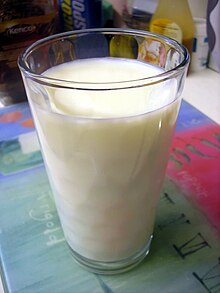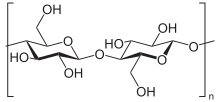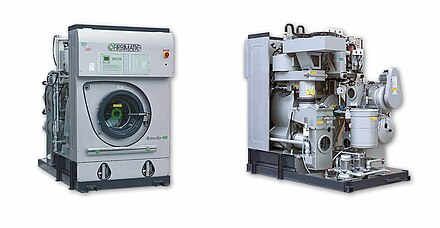In chemistry, a colloid is a mixture in which one substance of microscopically dispersed insoluble or soluble particles is suspended throughout another substance. Sometimes the dispersed substance alone is called the colloid; the term colloidal suspension refers unambiguously to the overall mixture (although a narrower sense of the word suspension is distinguished from colloids by larger particle size). Unlike a solution, whose solute and solvent constitute only one phase, a colloid has a dispersed phase (the suspended particles) and a continuous phase (the medium of suspension) that arise by phase separation. To qualify as a colloid, the mixture must be one that does not settle or would take a very long time to settle appreciably.
The dispersed-phase particles have a diameter between approximately 1 and 1000 nanometers. Such particles are normally easily visible in an optical microscope, although at the smaller size range (r < 250 nm), an ultramicroscope or an electron microscope may be required. Homogeneous mixtures with a dispersed phase in this size range may be called colloidal aerosols, colloidal emulsions, colloidal foams, colloidal dispersions, or hydrosols. The dispersed-phase particles or droplets are affected largely by the surface chemistry present in the colloid.
Some colloids are translucent because of the Tyndall effect, which is the scattering of light by particles in the colloid. Other colloids may be opaque or have a slight color. The cytoplasm of living cells is an example of a colloid, containing many types of biomolecular condensate.
Colloidal suspensions are the subject of interface and colloid science. This field of study was introduced in 1845 by Italian chemist Francesco Selmi and further investigated since 1861 by Scottish scientist Thomas Graham.
IUPAC definitionColloid: Short synonym for colloidal system. Colloidal: State of subdivision such that the molecules or polymolecular particles dispersed in a medium have at least one dimension between approximately 1 nm and 1 μm, or that in a system discontinuities are found at distances of that order.
Classification
Because the size of the dispersed phase may be difficult to measure, and because colloids have the appearance of solutions,
colloids are sometimes identified and characterized by their
physico-chemical and transport properties. For example, if a colloid
consists of a solid phase dispersed in a liquid, the solid particles
will not diffuse
through a membrane, whereas with a true solution the dissolved ions or
molecules will diffuse through a membrane. Because of the size
exclusion, the colloidal particles are unable to pass through the pores
of an ultrafiltration membrane with a size smaller than their own
dimension. The smaller the size of the pore of the ultrafiltration
membrane, the lower the concentration of the dispersed colloidal
particles remaining in the ultrafiltered liquid. The measured value of
the concentration of a truly dissolved species will thus depend on the
experimental conditions applied to separate it from the colloidal
particles also dispersed in the liquid. This is particularly important
for solubility studies of readily hydrolyzed species such as Al, Eu, Am, Cm, or organic matter complexing these species.
Colloids can be classified as follows:
| Medium/phase | Dispersed phase | |||
|---|---|---|---|---|
| Gas | Liquid | Solid | ||
| Dispersion medium |
Gas | No such colloids are known. Helium and xenon are known to be immiscible under certain conditions. |
Liquid aerosol Examples: fog, clouds, condensation, mist, hair sprays |
Solid aerosol Examples: smoke, ice cloud, atmospheric particulate matter |
| Liquid | Foam Example: whipped cream, shaving cream |
Emulsion Examples: milk (fat fraction), mayonnaise, hand cream; latex |
Sol Examples: milk (protein fraction), pigmented ink, blood | |
| Solid | Solid foam Examples: aerogel, styrofoam, pumice |
Gel Examples: agar, gelatin, jelly |
Solid sol Example: cranberry glass | |
Based on the nature of interaction between the dispersed phase and the dispersion medium, colloids can be classified as: Hydrophilic colloids: The colloid particles are attracted toward water. They are also called reversible sols. Hydrophobic colloids:
These are opposite in nature to hydrophilic colloids. The colloid
particles are repelled by water. They are also called irreversible sols.
In some cases, a colloid suspension can be considered a
homogeneous mixture. This is because the distinction between "dissolved"
and "particulate" matter can be sometimes a matter of approach, which
affects whether or not it is homogeneous or heterogeneous.
Interaction between particles
The following forces play an important role in the interaction of colloid particles:
- Excluded volume repulsion: This refers to the impossibility of any overlap between hard particles.
- Electrostatic interaction: Colloidal particles often carry an electrical charge and therefore attract or repel each other. The charge of both the continuous and the dispersed phase, as well as the mobility of the phases are factors affecting this interaction.
- van der Waals forces: This is due to interaction between two dipoles that are either permanent or induced. Even if the particles do not have a permanent dipole, fluctuations of the electron density gives rise to a temporary dipole in a particle. This temporary dipole induces a dipole in particles nearby. The temporary dipole and the induced dipoles are then attracted to each other. This is known as van der Waals force, and is always present (unless the refractive indexes of the dispersed and continuous phases are matched), is short-range, and is attractive.
- Entropic forces: According to the second law of thermodynamics, a system progresses to a state in which entropy is maximized. This can result in effective forces even between hard spheres.
- Steric forces between polymer-covered surfaces or in solutions containing non-adsorbing polymer can modulate interparticle forces, producing an additional steric repulsive force (which is predominantly entropic in origin) or an attractive depletion force between them. Such an effect is specifically searched for with tailor-made superplasticizers developed to increase the workability of concrete and to reduce its water content.
Preparation
There are two principal ways to prepare colloids:
- Dispersion of large particles or droplets to the colloidal dimensions by milling, spraying, or application of shear (e.g., shaking, mixing, or high shear mixing).
- Condensation of small dissolved molecules into larger colloidal particles by precipitation, condensation, or redox reactions. Such processes are used in the preparation of colloidal silica or gold.
Stabilization (peptization)
The stability of a colloidal system is defined by particles remaining suspended in solution at equilibrium.
Stability is hindered by aggregation and sedimentation phenomena,
which are driven by the colloid's tendency to reduce surface energy.
Reducing the interfacial tension will stabilize the colloidal system by
reducing this driving force.
Examples of a stable and of an unstable colloidal dispersion.
Aggregation is due to the sum of the interaction forces between particles.
If attractive forces (such as van der Waals forces) prevail over the
repulsive ones (such as the electrostatic ones) particles aggregate in
clusters.
Electrostatic stabilization and steric stabilization are the two main mechanisms for stabilization against aggregation.
- Electrostatic stabilization is based on the mutual repulsion of like electrical charges. In general, different phases have different charge affinities, so that an electrical double layer forms at any interface. Small particle sizes lead to enormous surface areas, and this effect is greatly amplified in colloids. In a stable colloid, mass of a dispersed phase is so low that its buoyancy or kinetic energy is too weak to overcome the electrostatic repulsion between charged layers of the dispersing phase. The electrostatic repulsion between suspended colloidal particles is most readily quantified in terms of the zeta potential, a measurable quantity describing electrical potential at the slipping plane in an electrical double layer.
- Steric stabilization consists in covering the particles in polymers which prevents the particle to get close in the range of attractive forces.
A combination of the two mechanisms is also possible (electrosteric
stabilization). All the above-mentioned mechanisms for minimizing particle aggregation rely on the enhancement of the repulsive interaction forces.
Electrostatic and steric stabilization do not directly address the sedimentation/floating problem.
Particle sedimentation (and also floating, although this
phenomenon is less common) arises from a difference in the density of
the dispersed and of the continuous phase. The higher the difference in
densities, the faster the particle settling.
- The gel network stabilization represents the principal way to produce colloids stable to both aggregation and sedimentation.
The method consists in adding to the colloidal suspension a polymer
able to form a gel network and characterized by shear thinning
properties. Examples of such substances are xanthan and guar gum.
Steric and gel network stabilization.
Particle settling is hindered by the stiffness of the polymeric matrix where particles are trapped. In addition, the long polymeric chains can provide a steric or electrosteric stabilization to dispersed particles.
The rheological shear thinning properties find beneficial in the
preparation of the suspensions and in their use, as the reduced
viscosity at high shear rates facilitates deagglomeration, mixing and in
general the flow of the suspensions.
Destabilisation
Unstable colloidal dispersions can form either flocs or aggregates as the particles assemble due to interparticle attractions. Flocs
are loose and flexible conglomerates of the particles, whereas
aggregates are compact and rigid entities. There are methods that
distinguish between flocculation and aggregation, such as acoustic spectroscopy. Destabilization can be accomplished by different methods:
- Removal of the electrostatic barrier that prevents aggregation of the particles. This can be accomplished by the addition of salt to a suspension or changing the pH of a suspension to effectively neutralise or "screen" the surface charge of the particles in suspension. This removes the repulsive forces that keep colloidal particles separate and allows for coagulation due to van der Waals forces. Minor changes in pH can manifest in significant alteration to the zeta potential. When the magnitude of the zeta potential lies below a certain threshold, typically around ± 5mV, rapid coagulation or aggregation tends to occur.
- Addition of a charged polymer flocculant. Polymer flocculants can bridge individual colloidal particles by attractive electrostatic interactions. For example, negatively charged colloidal silica or clay particles can be flocculated by the addition of a positively charged polymer.
- Addition of non-adsorbed polymers called depletants that cause aggregation due to entropic effects.
- Physical deformation of the particle (e.g., stretching) may increase the van der Waals forces more than stabilisation forces (such as electrostatic), resulting coagulation of colloids at certain orientations.
Unstable colloidal suspensions of low-volume fraction form clustered
liquid suspensions, wherein individual clusters of particles fall to the
bottom of the suspension (or float to the top if the particles are less
dense than the suspending medium) once the clusters are of sufficient
size for the Brownian forces
that work to keep the particles in suspension to be overcome by
gravitational forces. However, colloidal suspensions of higher-volume
fraction form colloidal gels with viscoelastic properties. Viscoelastic
colloidal gels, such as bentonite and toothpaste,
flow like liquids under shear, but maintain their shape when shear is
removed. It is for this reason that toothpaste can be squeezed from a
toothpaste tube, but stays on the toothbrush after it is applied.
Monitoring stability
Measurement principle of multiple light scattering coupled with vertical scanning
Multiple light scattering coupled with vertical scanning is the most
widely used technique to monitor the dispersion state of a product,
hence identifying and quantifying destabilisation phenomena.
It works on concentrated dispersions without dilution. When light is
sent through the sample, it is backscattered by the particles /
droplets. The backscattering intensity is directly proportional to the
size and volume fraction of the dispersed phase. Therefore, local
changes in concentration (e.g.Creaming and Sedimentation) and global changes in size (e.g. flocculation, coalescence) are detected and monitored.
Accelerating methods for shelf life prediction
The
kinetic process of destabilisation can be rather long (up to several
months or even years for some products) and it is often required for the
formulator to use further accelerating methods in order to reach
reasonable development time for new product design. Thermal methods are
the most commonly used and consists in increasing temperature to
accelerate destabilisation (below critical temperatures of phase
inversion or chemical degradation). Temperature affects not only the
viscosity, but also interfacial tension in the case of non-ionic
surfactants or more generally interactions forces inside the system.
Storing a dispersion at high temperatures enables to simulate real life
conditions for a product (e.g. tube of sunscreen cream in a car in the
summer), but also to accelerate destabilisation processes up to 200
times.
Mechanical acceleration including vibration, centrifugation
and agitation are sometimes used. They subject the product to different
forces that pushes the particles / droplets against one another, hence
helping in the film drainage. However, some emulsions would never
coalesce in normal gravity, while they do under artificial gravity. Moreover, segregation of different populations of particles have been highlighted when using centrifugation and vibration.
As a model system for atoms
In physics, colloids are an interesting model system for atoms. Micrometre-scale colloidal particles are large enough to be observed by optical techniques such as confocal microscopy.
Many of the forces that govern the structure and behavior of matter,
such as excluded volume interactions or electrostatic forces, govern the
structure and behavior of colloidal suspensions. For example, the same
techniques used to model ideal gases can be applied to model
the behavior of a hard sphere colloidal suspension. In addition, phase
transitions in colloidal suspensions can be studied in real time using
optical techniques,
and are analogous to phase transitions in liquids. In many interesting
cases optical fluidity is used to control colloid suspensions.
Crystals
A colloidal crystal is a highly ordered
array of particles that can be formed over a very long range (typically
on the order of a few millimeters to one centimeter) and that appear analogous to their atomic or molecular counterparts. One of the finest natural examples of this ordering phenomenon can be found in precious opal, in which brilliant regions of pure spectral color result from close-packed domains of amorphous colloidal spheres of silicon dioxide (or silica, SiO2). These spherical particles precipitate in highly siliceous pools in Australia and elsewhere, and form these highly ordered arrays after years of sedimentation and compression under hydrostatic and gravitational forces. The periodic arrays of submicrometre spherical particles provide similar arrays of interstitial voids, which act as a natural diffraction grating for visible light waves, particularly when the interstitial spacing is of the same order of magnitude as the incident lightwave.
Thus, it has been known for many years that, due to repulsive Coulombic interactions, electrically charged macromolecules in an aqueous environment can exhibit long-range crystal-like
correlations with interparticle separation distances, often being
considerably greater than the individual particle diameter. In all of
these cases in nature, the same brilliant iridescence (or play of colors) can be attributed to the diffraction and constructive interference of visible lightwaves that satisfy Bragg’s law, in a matter analogous to the scattering of X-rays in crystalline solids.
The large number of experiments exploring the physics and chemistry
of these so-called "colloidal crystals" has emerged as a result of the
relatively simple methods that have evolved in the last 20 years for
preparing synthetic monodisperse colloids (both polymer and mineral)
and, through various mechanisms, implementing and preserving their
long-range order formation.
In biology
Colloidal
phase separation is an important organising principle for
compartmentalisation of both the cytoplasm and nucleus of cells, similar
in importance to compartmentalisation via lipid bilayer membranes. The
term biomolecular condensate has been used to refer to clusters of macromolecules that arise via liquid-liquid, liquid-gel, or liquid-solid phase separation within the cytosol. Macromolecular crowding strongly enhances colloidal phase separation and formation of biomolecular condensates.
In the environment
Colloidal particles can also serve as transport vector
of diverse contaminants in the surface water (sea water, lakes, rivers,
fresh water bodies) and in underground water circulating in fissured
rocks
(e.g. limestone, sandstone, granite). Radionuclides and heavy metals easily sorb onto colloids suspended in water. Various types of colloids are recognised: inorganic colloids (e.g. clay particles, silicates, iron oxy-hydroxides), organic colloids (humic and fulvic substances). When heavy metals or radionuclides form their own pure colloids, the term "eigencolloid" is used to designate pure phases, i.e., pure Tc(OH)4, U(OH)4, or Am(OH)3. Colloids have been suspected for the long-range transport of plutonium on the Nevada Nuclear Test Site.
They have been the subject of detailed studies for many years. However,
the mobility of inorganic colloids is very low in compacted bentonites and in deep clay formations
because of the process of ultrafiltration occurring in dense clay membrane.
The question is less clear for small organic colloids often mixed in porewater with truly dissolved organic molecules.
In soil science, the colloidal fraction in soils consists of tiny clay and humus particles that are less than 1ɥm in diameter and carry either positive and/or negative electrostatic charges that vary depending on the chemical conditions of the soil sample, i.e. soil pH.
Intravenous therapy
Colloid solutions used in intravenous therapy belong to a major group of volume expanders, and can be used for intravenous fluid replacement. Colloids preserve a high colloid osmotic pressure in the blood, and therefore, they should theoretically preferentially increase the intravascular volume, whereas other types of volume expanders called crystalloids also increase the interstitial volume and intracellular volume. However, there is still controversy to the actual difference in efficacy by this difference, and much of the research related to this use of colloids is based on fraudulent research by Joachim Boldt. Another difference is that crystalloids generally are much cheaper than colloids.






















